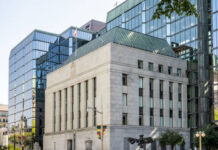The US inflation jumped to 2.6% year-on-year in March, slightly higher than 2.5% penciled by analysts, and the halt in Johnson Johnson’s vaccine pulled away the attention from rising consumer prices to an endless pandemic that boosted to stay-home stocks. Worries of slower vaccination and steady US yields following the jump in inflation sent Nasdaq and S&P500 to record. Nasdaq closed Tuesday’s session 1.05% higher, while banks and consumer staples retreated on news. J&J slid 1.34%. The US said there are enough Pfizer and Moderna doses to carry on with vaccines.
The US 10-year yield eased after the March inflation data, and the 30-year treasury auction went well.
There was no better combination than rising inflation and tame US yields for gold bulls. The price of an ounce advanced to $1750. The next important test is the 50-day moving average, $1755 per oz, if cleared could reverse the medium-term positive trend in gold.
The US dollar eased, the EURUSD approached the 1.20 mark despite a worsening economic sentiment in the Eurozone according to the latest ZEW survey. Meanwhile, the European Central Bank’s (ECB) balance sheet advanced to the highest, as the total assets rose more than $20 billion on QE purchases. As such, the ECB’s balance sheet is up to 70% of the Eurozone GDP, versus 36% of the Federal Reserve (Fed). The divergence between a more dovish ECB and a more hawkish Fed will likely limit the upside potential in the EURUSD.
Bitcoin rallied to a fresh all-time-high ahead of today’s Coinbase IPO. Coinbase’s listing in Nasdaq will be the first official crossroads between traditional finance and the alternative crypto market. Coinbase’s debut in Nasdaq will be an important test for the crpyto-industry: either the traditional asset managers will share the joy and the crypto-mania will carry on in Nasdaq, or the event will be a flop. At this point, it is hard to imagine anything less than a fantastic debut for Coinbase in Nasdaq. The company announced it earned $1.8 billion in the first quarter, near 80% more than the entire 2020. Revenues grow in line with the crypto-mania, which could be one sticky point for traditional investors, as three out of four believe that Bitcoin is in a bubble according to a Bank of America survey. Only 7% of the same think that stock prices are exaggeratedly higher, to give a point of comparison. Therefore, the short-sellers won’t be too far. Yet, one needs to have solid nerves to short a stock that could skyrocket to God-knows-where as it enters the champions’ arena.
The reference price for Coinbase is set to $250 per share. This is just a reference price, and this is not the price the stocks will start trading. The chances are that the Coinbase shares could at least double the reference price in its first trading hours.
And, Bitcoin and Coinbase will likely have their destinies tied together for the day.
Else, GRAB announced it will go public via Altimeter Growth Corp, which is a SPAC. And it will be the biggest SPAC deal of the kind. The deal comes at a time SPACs came under the scrutiny of US authorities, as they could be considered as a liability rather than stock investment according to the latest news. But the most recent news didn’t give cold feet to SPAC investors, as they pushed Altimeter Growth’s share price 10% higher following the news of its merger with Grab.
Grab will take a chance in the US SPAC boom, and will be listed in Nasdaq in a few months. Grab is one of the most promising Asian tech unicorns, it holds about 72% of Asia’s ride-hailing market, half of food deliveries and nearly a quarter of digital wallet payments. The company is expected to return positive earnings from 2023 and is valued a touch below $40 billion. The only thing that could get on the way is an eventual loss of appetite in growth stocks, as prospects of tighter financial conditions globally push investors towards revenue-generating value names.
On the earnings front, JPMorgan and Wells Fargo will announce results today and the numbers will hint at the health of the banking sector. The hostile rate environment and lower market volatility that may have weighed on big banks’ earnings in the last quarter.












